Notre Dame Cathedral Paris – A Legendary Landmark Lives Again
Notre Dame Cathedral Paris, with its flying buttresses, bell towers, scowling gargoyles, and legendary spire, nearly vanished into flames on April 15, 2019. Imagine — almost nine hundred years of drama, gothic glory, and even Roman intrigue (yes, there's a Roman archaeological crypt beneath it!) nearly reduced to ash in one dreadful evening.
But Notre-Dame has bounced back. After an epic restoration, visitors can now (or at least starting sometime in 2025) again climb the cathedral's iconic 387 steps for the famous views across Paris. Meanwhile, to visit the church itself it is now recommended to book a reserved time slot.
![]()
Discover What's On When You're Here...
• January... |
• February... |
• March... |
• April... |
• May... |
• June... |
• July... |
• August... |
• September... |
• October... |
• November... |
• December... |
Discover What's On When You're Here
• January...
|
• February... |
• March... |
|---|---|---|
• April... |
• May... |
• June... |
• July... |
• August... |
• September... |
• October... |
• November... |
• December... |
A Close Call For An Historic Landmark
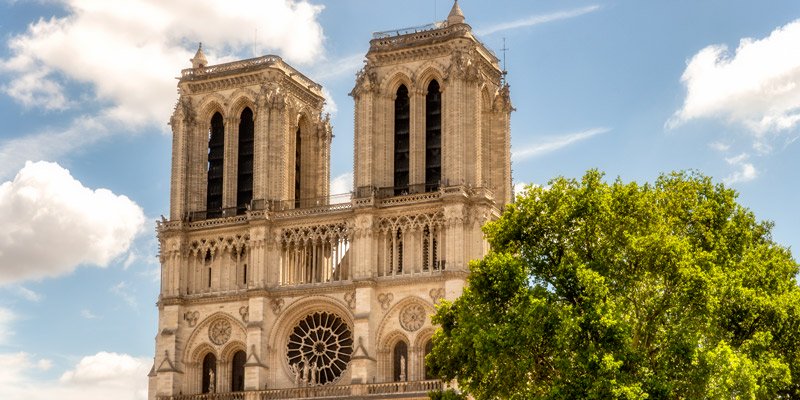 Notre Dame Cathedral Paris in happier times, July 2017 photo by Mark Craft
Notre Dame Cathedral Paris in happier times, July 2017 photo by Mark Craft
There's been a church on this prime patch of Île de la Cité, since the early Middle Ages, but in 1160, the Bishop of Paris decided to level up. He wanted something more showy, more… Gothic. And thus, Notre Dame Cathedral Paris emerged, pioneering the use of those daring flying buttresses — medieval tech marvels that allowed the walls to soar sky-high without toppling over.
Let's dive deeper into Notre Dame's epic past, the inferno that nearly spelled doom, and the revival story that has captivated Paris — and the world. We'll also show you some of the over-the-top designer proposals to replace the roof. (Spoiler: none of them happened.)
![]()
Find Hotel Deals for Your Dates in Paris
Check the complete list of Paris hotels to find current sale prices on rooms in every arrondissement. Save 10%, 20%… or even more! |
Paris Hotel Deals |
Find Hotel Deals for Your Dates in Paris
Save on hotels in every arrondissement of Paris – the Latin Quarter, Saint Germain, the Right Bank, the Marais, near the Eiffel Tower. Save 10%, 20%… or even more! |
The Notre Dame Cathedral Fire – Paris Holds Its Breath
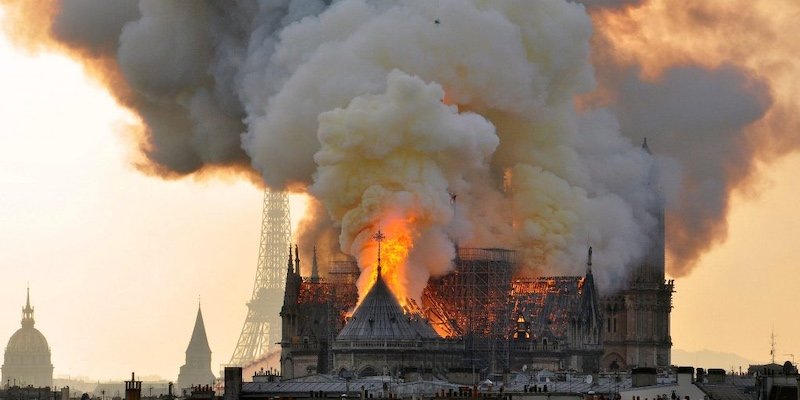 Fire at Notre Dame on April 19, 2019
Fire at Notre Dame on April 19, 2019
At precisely 6:20 PM on April 15, 2019 — a perfectly ordinary Monday until it wasn't — the first fire alarm echoed through Notre Dame Cathedral Paris. Nothing seemed amiss at first glance. Then, at 6:43 PM, came alarm number two, this time unmistakably real. Flames erupted in the attic, fueled by fierce winds and centuries-old timber.
Within mere hours, the dramatic 19th-century spire (a piece of architectural swagger by Eugène Viollet-le-Duc) crashed spectacularly into the cathedral's interior. Part of the roof quickly followed. Things got so dicey, the entire Île de la Cité had to be evacuated. The cathedral's survival hung by a thread, but thanks to nearly 500 firefighters working tirelessly, the main structure, bell towers, and dazzling stained-glass Rose Windows were miraculously spared. Even the 180,000 bees in the rooftop hives survived — perhaps the luckiest bees in France.
In the heat of the moment, a human chain of firefighters and courageous volunteers formed to rescue priceless relics, including what many is purported to be Christ's Crown of Thorns. Chaplain Jean-Marc Fournier — no stranger to heroics since his efforts during the 2015 terrorist attacks — charged into the smoke-filled cathedral to save sacred artifacts.
![]()
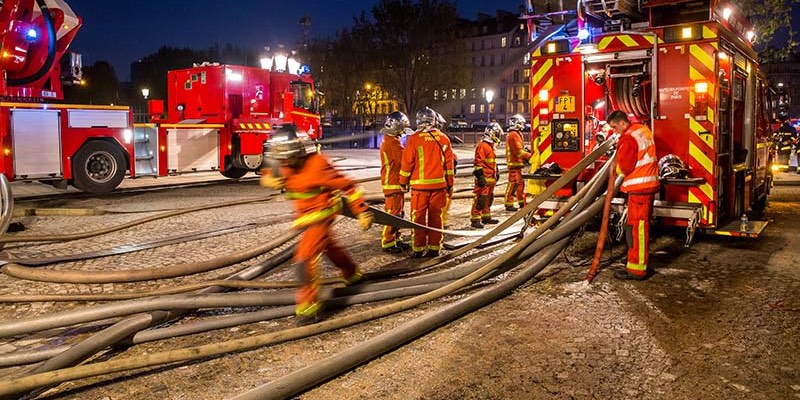 Some of the 500 firefighters at the scene.
Some of the 500 firefighters at the scene.
![]()
How did the blaze began? The jury's still out. Maybe an electrical glitch, perhaps a rogue cigarette butt left behind during renovations — typical old-building drama, given Notre Dame's lack of sprinklers and modern fire barriers.
The legendary bell towers (famous from Victor Hugo's tale of the hunchback) made it through unscathed, along with the mighty 340-year-old Emmanuel bell — unrelated to any serving presidents, of course. A lucky twist: sixteen irreplaceable copper statues, representing apostles and evangelists, had been whisked away for cleaning just days before.
Despite the close call, Notre Dame Cathedral Paris lost just five to ten percent of its treasures. Among the few heartbreakers were small relics associated with Parisian patron saints Denis and Geneviève, along with a fragment from the Holy Crown of Thorns.
Notre Dame weathered the ultimate test of resilience — and today, it remains Paris's beloved, if slightly shaken, superstar landmark.
The Ambitious Restoration of Notre Dame
 Notre Dame Cathedral Paris during the restoration, September 2019 photo by Mark Craft
Notre Dame Cathedral Paris during the restoration, September 2019 photo by Mark Craft
Just days after the flames subsided, President Emmanuel Macron confidently vowed to restore Notre Dame within five short years — because, let's face it, Paris isn't exactly known for its patience. The ambitious restoration of Notre Dame quickly became one of France's greatest cultural rescue missions, complete with an elaborate scaffolding system topped by an ingenious umbrella designed to shield the iconic cathedral from the elements.
Every step of the restoration was executed with remarkable precision and reverence, using traditional methods and materials that mirror the cathedral's original construction. Oak trees sourced from all corners of France (it takes a nation to raise a cathedral!) were meticulously selected to rebuild the ancient timber framework of the roof. Specialists have painstakingly analyzed every detail, replicating original materials and techniques to ensure the cathedral's authenticity shines through every newly placed stone and timber.
Notre Dame Reborn: Highlights of the Restored Cathedral
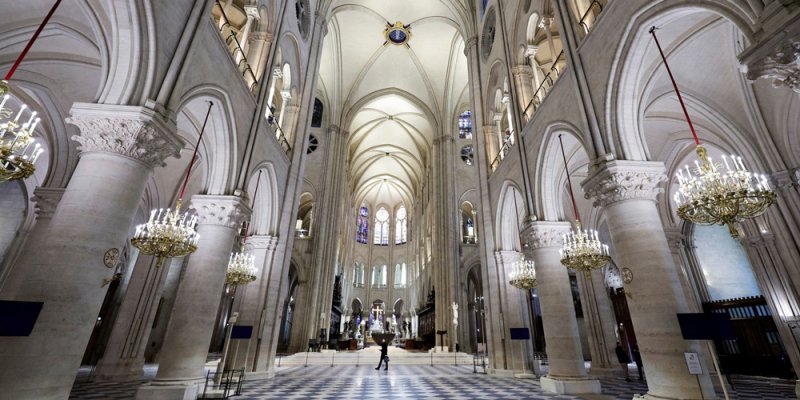 The interior of Notre Dame Cathedral Paris after the restoration, photo Reuters-Skynews
The interior of Notre Dame Cathedral Paris after the restoration, photo Reuters-Skynews
Notre Dame's restoration may have prioritized historical authenticity, but visitors with sharp eyes might catch some delightful enhancements:
- The Spire: Rising again exactly as envisioned by Viollet-le-Duc in the 19th century, the spire proudly reclaims its spot piercing the Parisian skyline — perhaps a bit smugly.
- The Roof: Expertly reconstructed with traditional oak timbers, the new roof proudly showcases the artistry and craftsmanship worthy of its medieval predecessors.
- Cleaned Facade: After an extensive facelift, the exterior stonework now gleams with its original, pristine color, highlighting intricate sculptures and carvings previously hidden beneath centuries of grime.
- Restored Stained Glass: The stained-glass windows have undergone a thorough cleaning, and their vibrant colors now dazzle visitors, inviting sunlight to dance across the cathedral's floors in an enchanting display.
Visiting Notre Dame Today
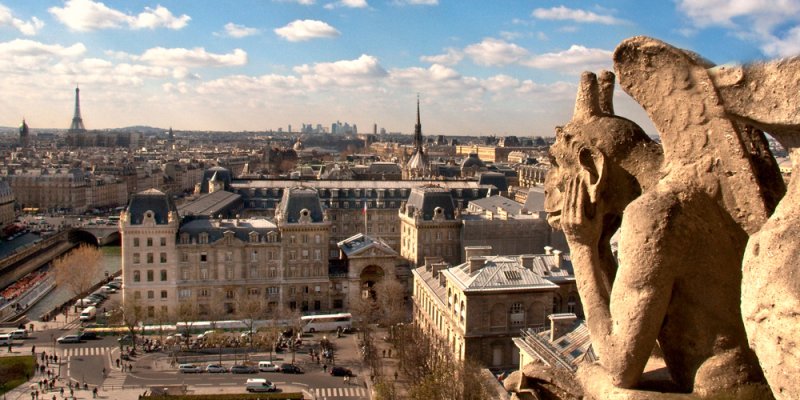 A gargoyle's view of Paris: from the Notre Dame bell towers, 2012, photo by Mark Craft
A gargoyle's view of Paris: from the Notre Dame bell towers, 2012, photo by Mark Craft
Notre Dame Cathedral has triumphantly reopened its doors to visitors. But here's an Insiders tip — due to overwhelming popularity (and understandably tight security measures), booking a reserved time slot online before your visit isn't just recommended, it's essential if you prefer marveling at the architecture rather than spending your afternoon marveling at the length of the queue.
Guided City Walk – Notre Dame Cathedral & Île de la Cité
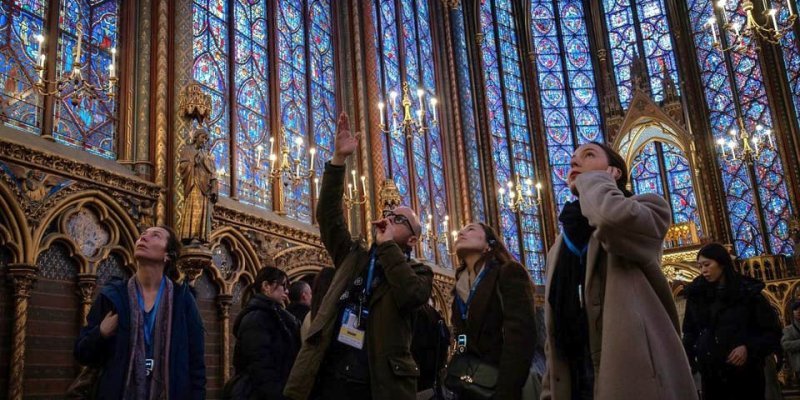 A visit to La Sainte Chapelle is part of the Guided City Walk"
A visit to La Sainte Chapelle is part of the Guided City Walk"
Take a walk through the history of Paris. For thousands of years Paris has endured many challenges and hardships, including the fire that threatened to destroy the legacy of Notre Dame Cathedral. But she's a survivor. As experts reconstruct the 860-year-old UNESCO landmark, take this insider's tour that takes you on a special walk through the epicenter of Paris.
The tour starts at her home on Île de la Cité, where you'll discover the history and majesty of this tiny island. Wander past the historic outdoor flower market, the Palais de Justice, and see Marie Antoinette's final home in the Conciergerie prison before you come to the plaza in front of Notre Dame. Marvel at her survival as your guide fills you in on the past, present, and future of this Paris icon.
Construction & Renovation Through the Centuries
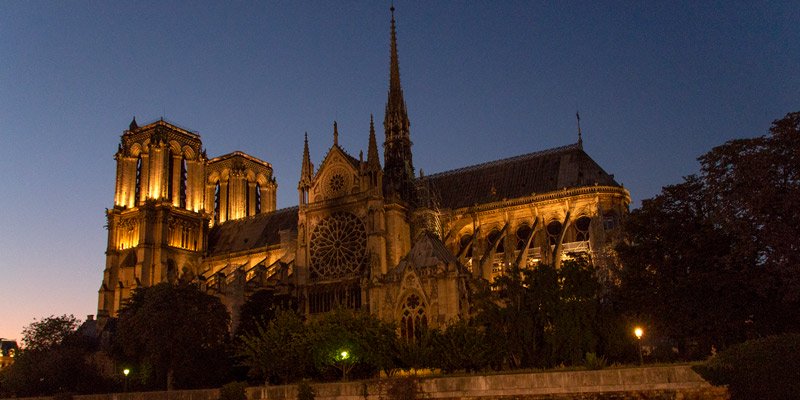 Notre Dame seen from the Seine, photo by Mark Craft
Notre Dame seen from the Seine, photo by Mark Craft
Like Rome, Notre Dame wasn't built in a day — far from it, actually. It was a wildly complicated endeavor spanning 182 years, during which construction techniques literally evolved alongside the rising cathedral walls. Bishop Sully, who initiated this colossal project, made it his life's work and poured his his entire fortune into the cathedral — talk about dedication. Generation after generation, bishop after bishop, architect after architect, Notre Dame slowly took shape throughout the twelfth and thirteenth centuries.
The iconic design of Notre Dame didn't just spring fully formed from Bishop Sully's imagination; it was an evolving masterpiece, shaped by countless architects, craftsmen, and laborers. Flying buttresses — those graceful supports that now define Gothic architecture — were a mid-project innovation introduced out of sheer structural necessity.
Today, if you peer closely at the cathedral, you'll spot distinct variations in style and construction techniques that whisper stories of centuries past. Sculptors with varying styles and imaginations left their marks through statues and gargoyles perched around the building. And here's a fun fact: originally, all these sculptures — even the walls themselves — were vibrantly painted.
![]()
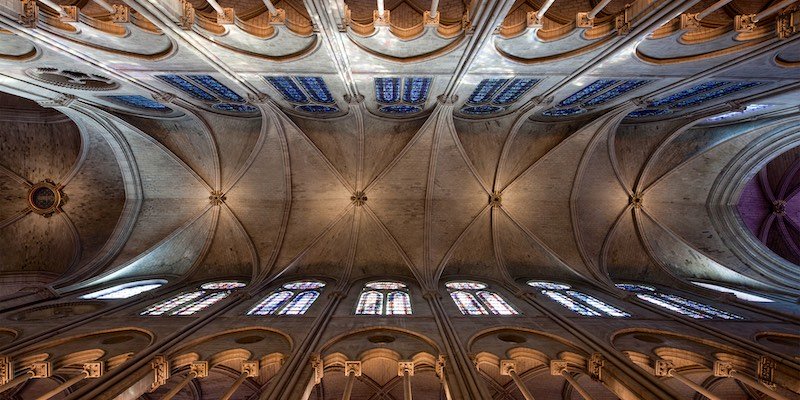 Looking up at Notre Dame's vaulted ceiling, photo Notre Dame Cathedral Paris
Looking up at Notre Dame's vaulted ceiling, photo Notre Dame Cathedral Paris
![]()
Even after its original completion, Notre Dame continued to change with the times. The Renaissance brought tapestries that obscured Gothic pillars and walls, while Louis XIV and Louis XV couldn't resist adding their royal flair, including swapping out stained glass windows and introducing a grand marble altar. Even the spire wasn't safe — it was removed after wind damage in the mid-18th century.
After narrowly surviving as a storage warehouse post-French Revolution, it was Victor Hugo's 1831 novel, The Hunchback of Notre Dame, that rekindled public affection for the cathedral. Architects Jean-Baptiste-Antoine Lassus and Eugène Viollet-le-Duc spent 25 years breathing new life into Notre Dame, simultaneously restoring its grandeur and boldly adding new elements, including the famously ornate, taller spire.
Eight centuries and counting, Notre Dame has captivated visitors (nine million annually before the fire, to be exact). Since the cornerstone was laid in 1163, it's been a testament to human ambition, ingenuity, and the occasional stroke of genius. The groundbreaking flying buttresses? Pure medieval engineering brilliance. A massive restoration effort begun in 1991 was, ironically, still underway when the tragic fire struck.
Notre Dame Cathedral Paris Resources
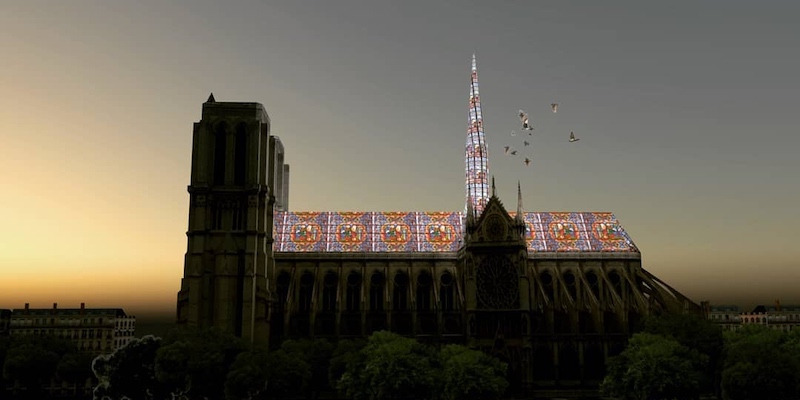 One of the fanciful proposals to replace the traditional roof
One of the fanciful proposals to replace the traditional roof
- 6 Parvis Notre-Dame, Place Jean-Paul II
- Île de la Cité
- 4th Arrondissement
- Cathedral Website…
Outlandish Visions: The Notre Dame That Could Have Been
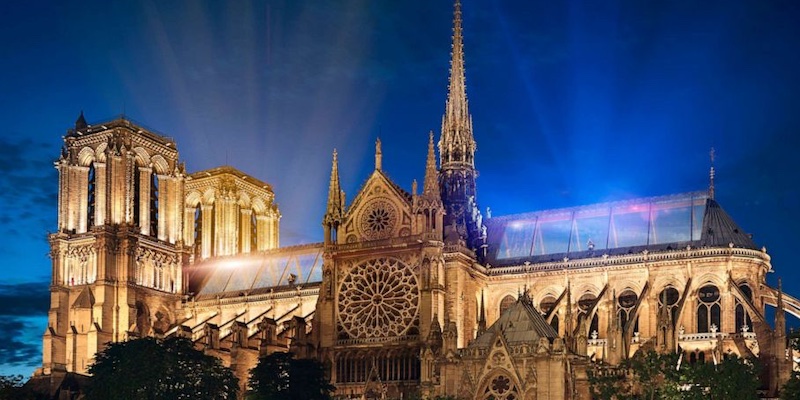 Another see-through light-show roof proposal. None of these modernist twists were adopted.
Another see-through light-show roof proposal. None of these modernist twists were adopted.
After the devastating 2019 fire at Notre Dame Cathedral Paris, architects and designers worldwide boldly unleashed their most extravagant and downright eccentric proposals for the cathedral's roof and spire. While none of these imaginative ideas seriously threatened the restoration committee's sanity, they certainly sparked animated public debate — and plenty of raised eyebrows.
One spectacularly audacious idea from Ulf Mejergren Architects envisioned transforming the cathedral's roof into a giant swimming pool, complete with open-air views "unmatched over Paris" and guarded by the twelve apostle statues that had miraculously escaped the blaze.
French designer Mathieu Lehanneur proposed an equally flamboyant concept — a glittering, gold-leaf-covered flame rising dramatically 300 feet above the cathedral, meant to commemorate the very disaster it survived.
Yet perhaps the most deliciously absurd suggestion came from Sebastian Errazuriz, who mockingly pitched converting the rooftop into a rocket launchpad to lampoon the architects eagerly vying for attention. Other wild and whimsical designs included turning the roof into a giant greenhouse, constructing a spiraling stained-glass spire, and — wait for it — adorning the cathedral with a McDonald's-style red roof, complete with golden arches. Clearly, creativity has no limits — even if practicality occasionally does.
Paris Planning Guides
 10 Food Experiences
10 Food Experiences |
 Book an Airport Transfer
Book an Airport Transfer |
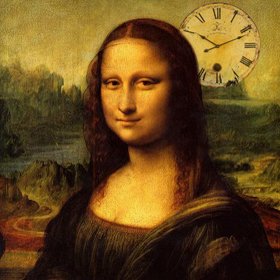 Skip-the-line Louvre Tour
Skip-the-line Louvre Tour |
 Glorious Dinner Cruises
Glorious Dinner Cruises |













